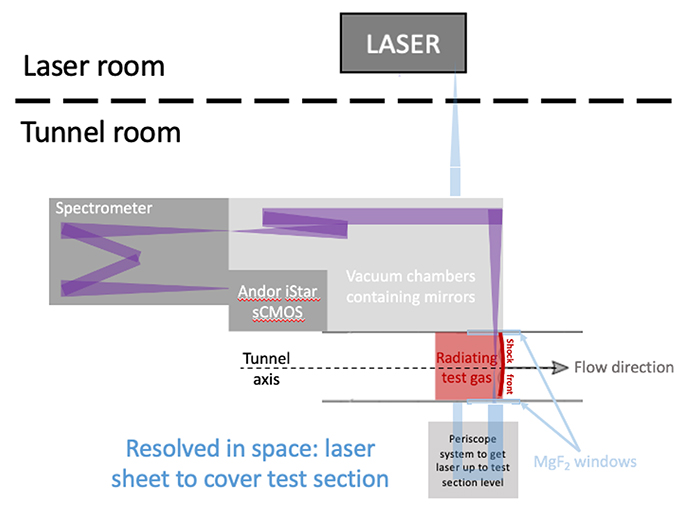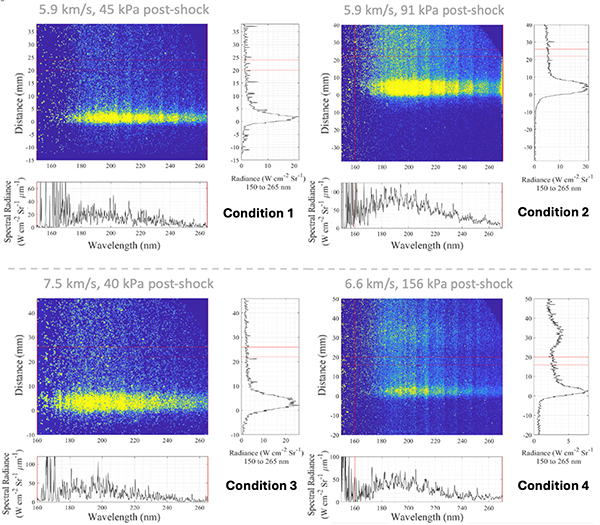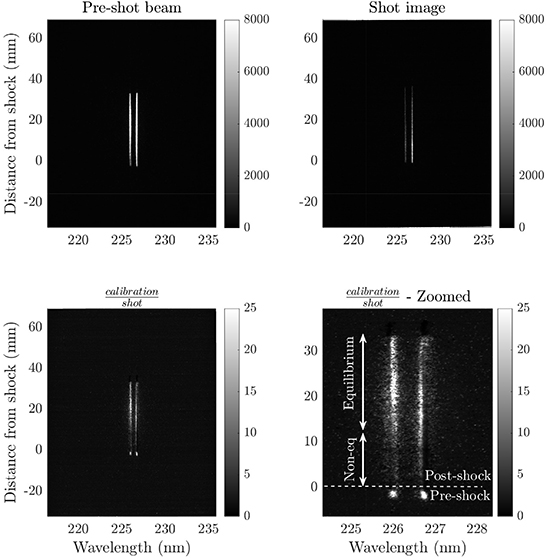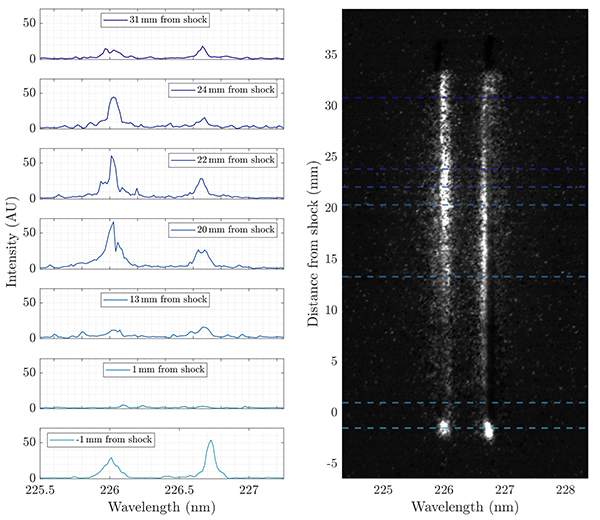Resources
 Part of the Oxford Instruments Group
Part of the Oxford Instruments Group
Expand
Collapse
 Part of the Oxford Instruments Group
Part of the Oxford Instruments Group
Atmospheric re-entry results in intense heat flux onto the surface of the flight vehicle due to the high enthalpy of the surrounding flow field. A major source of uncertainty in predicting this heat flux is thermochemical non-equilibrium, which significantly affects surface heat flux, shear stress, gas radiation, and overall flow characteristics. Because computational models can have prediction errors as high as ±80% [1], thermal protection systems are often heavily oversized, leading to excessive vehicle mass that limits both performance and payload capacity.
To improve the design of hypersonic and re-entry vehicles, more accurate prediction of non-equilibrium flows is needed. Ground testing aims to recreate flight-relevant flow conditions to study key flow features. One such canonical experimental setup is the shock tube, where a normal shock transiently passes through a straight tube [2, 3, 4, 5, 6]. The shock speed is representative of the desired flight condition, and the test gas composition and density match that of the atmospheric free stream during flight. Optical diagnostics such as optical emission spectroscopy (OES) [3, 7, 8] and laser absorption spectroscopy (LAS) [9, 10] allow analysis of the gas radiation and thermochemistry near the shock. Both OES and LAS resolve the spectral properties of high-enthalpy flows, though they generate fundamentally different types of data.
The test facility utilised in this work is the T6 Stalker Tunnel [11, 12, 13, 14] in shock tube mode. The strong driver conditions of T6 enable high shock velocities while retaining a large tube diameter. This long optical path enables a higher signal-to-noise ratio in the measurement of spectroscopic data while minimising exposure times to reduce spatial blurring due to shock movement. This project used two diagnostics: a vacuum-ultraviolet (VUV) OES setup that images light from the test section, and an ultraviolet LAS setup that combines these imaging optics with a custom modeless dye laser of tunable wavelength profile. Since molecular oxygen and water vapour absorb VUV light in ambient air, the setup must operate either in an oxygen-free dry gas environment or under high vacuum; the latter is used in this work. A system of mirrors inside vacuum chambers directs the light from the test section onto an intensified P43 iStar sCMOS (iSTAR-SCMOS-18U-05) camera connected to a McPherson 207V spectrometer to spatially resolve the spectra.

Fig. 1 [15]: Schematic of the optical diagnostics on the tunnel, with the VUV-enhanced imaging spectroscopy set-up on one side of the tunnel (top) and UV laser entering the test-section from the diametrically opposite window (bottom). Their optical paths are shown in purple and blue respectively.
Flow conditions investigated in this work include velocities between 3.3 km.s−1 and 10 km.s−1, with post-shock pressures varying between 13 and 150 kPa, to observe how the thermochemistry in both non-equilibrium and equilibrium regions vary with pressure and velocity.
The four cases shown in Fig. 2 include two lower-speed cases (top) and two slightly higher-speed cases (bottom), each with low (left) and high (right) post-shock pressures. This setup allows the effect of pressure and velocity on gas thermochemistry in both non-equilibrium and equilibrium regions to be investigated. From the radiance plots, it is observed that low post-shock pressure conditions tend to relax to equilibrium levels similar to the pre-shock state, whereas high post-shock pressures result in higher equilibrium levels. Because fewer particles are present at low pressures, the non-equilibrium region extends further spatially due to fewer collisions—this trend is seen at lower speeds but not at higher ones. Greater particle density and increased NO dissociation at high pressures could lead to more self-absorption, possibly explaining why radiance in Condition 4 is roughly half that of Conditions 1, 2 and 3. Further analysis of these spectra will be conducted by comparing them with thermochemical and radiative simulations to determine number densities of high-energy species and quantify self-absorption effects.

Fig. 2 modified from [15]: Spatially resolved VUV emission spectra for a high and low-speeds, and high and low post-shock pressures.
Images of the laser beams were captured before the shot using the same camera gain settings (top left of Fig. 3) and will be scaled to correct for intensity differences due to Q-switch gating. This calibration image is used to normalise the shot image and reveal absorption features, as seen in the top right of Fig. 3. In this case, the absorption was so strong that the beam was nearly entirely absorbed. For visualisation and comparison, the intensity in the top two images of Fig. 3 was capped at 8000, which saturates the pre-shot beam signal (up to 50,000 in raw counts) but renders the shot image visible on a comparable scale.
A more accurate calibration method using the pre-shock data—where the laser signal is unaffected by the flow—will be implemented in future work (bottom right of Fig. 3). This provides a calibration reference under matching conditions (background, gating time, and pulse intensity) to those during absorption. Fig. 4 displays spatially resolved absorption features at various distances from the shock front: undisturbed pre-shock, a fully absorbed non-equilibrium region, and a relaxation region where the signal re-emerges roughly 20 mm downstream. The relative intensity of the two beams changes compared to the pre-shock signal, with the longer-wavelength beam initially more intense, showing stronger absorption around 226.71 nm. Peaks at 225.96 and 225.99 nm also appear further downstream in the shorter-wavelength beam. These absorption features provide data for resolving the absolute spatial variation in number density of low-energy quantum states.

Fig. 3 [15]: Pre-shot beam (top left) compared to beam as the shock wave passes through the test section (top right). The bottom part shows the ratio of calibration and shot signal. The location of the shock wave can be identified by the sharp change in beam intensity. Intensities are in pixels counts (AU).

Fig. 4 [15]: Spatially resolved absorption features at different locations. Bottom to top: 1) pre-shock, 2-3) non-equilibrium bounds, and 4-7) relaxation regions.
Date: August 2025
Author: Maïlys T. B. Buquet, Benjamin A. O. Williams, Paul Ewart, Alex Glenn, Matthew McGilvray and Tobias Hermann, University of Oxford
Category: Application Note
